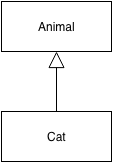Reasoning about subtype relations between parameterised types tend
to confuse developers. If you are a Java developer you've probably seen
the syntax ? extends T and ? super T, or might even used it to
create flexible method signatures. I was very confused at first when I
tried to use them as their meaning wasn't clear to me. So, I just
placed extends everywhere, and changed it to super when the compiler
complained. Where is it even valid to place only super types of some
T? It made no sense to me at first. But as it turns out, it makes all
the sense. Let's start at the beginning. Say you have a Cat class
extending the Animal class. Here, Cat is the subtype of Animal, by
definition.

Now, let's create four XInYOut classes, each of them having a single
method apply, and use these two classes with them. It doesn't matter
what this apply method does, we only care about its signature:
it takes one input parameter, and returns an output. Why do we create
four? To cover all combinations of the Animal and Cat classes, in
the input and output parameters. Without generic parameters yet, what
are possible subtyping relations between these classes? The most
straightforward is that AnimalInCatOut is a subtype of
AnimalInAnimalOut, because wherever you return an Animal you could
also return a Cat as it is its subtype. The same thing applies
to CatInCatOut and CatInAnimalOut.


Might be a bit trickier to see that AnimalInAnimalOut is a subtype
of CatInAnimalOut. The first one can replace the second one on
call-site without breaking type safety, because the caller expects
something the needs a Cat , and so they must provide an argument that
is subtype of Cat, and this always satisfy Animal. Of course the
same applies to AnimalInCatOut and CatInCatOut.


AnimalInCatOut and CatInAnimalOut combine both treats of the upper
two cases; both the former's input a supertype, the output the subtype
of the latter. So AnimalInCatOut is a subtype of CatInAnimalOut.
Lastly, CatInCatOut cannot be a subtype of AnimalInAnimalOut as it
breaks the contract of its input parameter, vice versa it breaks the
output, so there is no relation between them. To sum things up:

Now, onto generics. Let's make one generic class by depending on two
types: In and Out.

The same rules applies here as well:
Function<Animal, Cat>is a subtype ofFunction<Animal, Animal>andFunction<Cat, Cat>is a subtype ofFunction<Cat, Animal>. Here the subtype relation's direction of the dependent typeFunctionis the same as the parameterOut, makingOuta covariant type parameter.Function<Animal, Animal>is a subtype ofFunction<Cat, Animal>,Function<Animal, Cat>is a subtype ofFunction<Cat, Cat>. Here the subtype relation's direction of the dependent typeFunctionis opposite to the direction of the subtype relation between the parameterInmakingIna contravariant type parameter.- Making use of both parameters' variance,
Function<Animal, Cat>is a subtype ofFunction<Cat, Animal>.
In some languages, like Scala, variance is declared class level,
using + for covariant, - for contravariant parameters.

In Java however, the developer has a cumbersome job: the language does
not known class level variance. Instead one has to specify the type
variables' variance every place they are used: ? extends T for
covariant, ? super T for contravariant positions. If you miss to
specify the variance at a place, you lose the information for consequent
uses.
Hope this clarified things a bit about type variance. Cheers!